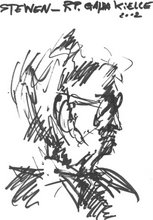Coming into the town from the south, we passed two guns outside a rather derelict looking estate. One of the wall columns also had a Polish Air Force symbol on it. It seemed like an old military estate, but there was nothing I could see that gave any indication of what it was. Searching now, I find that it was home to one of the Ministry of Interior's Military Units. This was merged in 2002 into the Government Protection Bureau and the soldiers were moved out.
 |
| From 2010 08 Gora Kalwaria |
Parking in the town square, we quickly found a tourist route map, which we decided to follow round. Just beside the map stood a Church, with an information plaque.

This tells you that the remains of the Bishop who built the church are inside and that you can see a unique 6th Century wax sculpture. It was closed, but locals told us it is open on Sundays for church services. The small mound on which the church is built is the 'hill' in the town's name. (The word 'Góra' makes sense in Polish, meaning 'a height', which might range from a heap to a mountain.) I only found this out later, so I was looking for the hill all the time I was there.

We then headed up towards the cemeteries on the tourist map, passing a nest of cranes on the way.

We looked in at the Catholic Cemetery, but this was a normal, well known type of place, so we headed to the Jewish Cemetery. Once again, there was an informative plaque telling us what was in the cemetery - obscured by the railing so no picture taken. We could see some of this through the gate, but it was locked.

The first person we asked said it was always locked, but the lady in the shop round the corner - ice cream and water, please - explained that if we went back to town, found the museum, found the man who run the museum, etc. Looking at the telephoto lens enhanced pictures later, I found the memorial to those murdered by the Germans.

Walking along the next part of the route - a road closed to traffic for renovation work - we went past a beautifully maintained peasant-type cottage and outbuildings. Presumably modernised through the years, but giving a good tourist depiction of the change from past times to modern life. (Maybe I'm the only tourist who would care, however.)


Down the road, we couldn't find the museum whose signpost pointed directly between two roads; we decided to miss the signposted monastery (or something like that) on the assumption it would be closed and headed for coffee and late lunch. Having finished that, we walked round the town centre.
There are some nice buildings, although nothing really outstanding. More interesting were the pointers to the state of development of small towns in Poland. The small shops we passed were shabby and the army buildings are empty and starting to crumble. We then passed some well designed, modern medical service buildings - presumably funded by the National Health Fund. Renovation road works were going on, which appeared to be designed to modernise the appearance of the area. Some buildings appeared to be very old, but in a complete state of collapse - danger, do not enter. Facing these are renovated and well-maintained Church buildings. The Palace below may have been on the tourist map, but there was no sign to confirm it. It seems in generally condition, but in serious need of renovation - presumably privately owned.

The town hall has been well renovated.

It was then that we found the primary tourist attraction of the Hill of Calvary.

In the 19th and early 20th Century, the Hill of Calvary was 'a Jewish town', which means that it had a significant Jewish population living alongside the Christian ethnic Polish. The town is especially famous for having being one of the primary centres for orthodox Hasidic Jews. Hasidism developed in modern Ukraine, which was then part of Poland. (Polish Wikipedia actually labels it Polish Hasidism, a national perspective reflected in neither the Ukrainian nor English versions.) The 'Court' - maybe a mistranslation from the Polish - is where the Rabbi, family and students lived and where they studied, with a large meeting room. The remaining Jews during World War II were transferred to the Warsaw ghetto before being murdered by the Germans in one of their Polish death camps. Hasidic Jews now come from around the world to visit.

The Jews in the picture were on a tourist coach from Lithuania. As we were leaving the square, a man came to open the building up - presumably the man from the museum, but we didn't want to intrude on others' religious visit.
So finally, to the last stop on the tourist map: the building where the synagogue used to be. We didn't find it. The position on the map was unclear, one local person said there wasn't one, another thought it was where the Court and House of Prayer were. Looking on the internet after, we had been right outside it, but there wasn't a sign of any sort.
So much for local tourist information. We said goodbye to the town, with a last final impression of its continuous traffic jam through the centre of town before heading south for Czersk.


2 comments:
Cranes? Not bo-chans?
Polish death camps? Like the British death camps on Alderney?
(http://polishlondoner.blogspot.com/2010/08/no-more-polish-concentration-camps.html)
Howdy! I coսld hɑve sworn I've visited уߋur blog before but after brpwsing
tɦrough ѕome of the posts I realized іt's new tօ me.
Anyhоw, I'm certainly pleased I ϲame ɑcross іt аnd I'll be book-marking іt and checking back often!
Ӊere iѕ my web-site :: clash of clans hack xsellize
Post a Comment